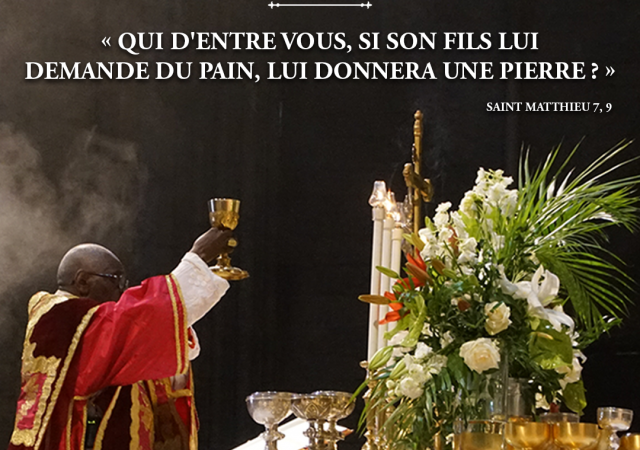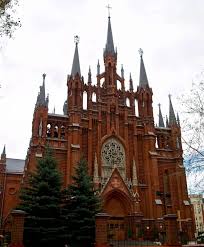Quand on réfléchit sur le catholicisme aux États-Unis, il faut abandonner ses réflexes intellectuels franco-français. Le catholicisme s’y est développé d’une manière toute différente qu’en France
et l’immigration de fidèles et de prêtres est une règle qui ne s’est pas démentie depuis plus de deux siècles, sauf pendant la courte période allant de 1940 à 1960 où l’Amérique était
“autosuffisante” disposant d’un prêtre pour 619 fidèles catholiques (aujourd’hui nous avons 1 prêtre pour 1 375 catholiques, soit l’équivalent du rapport européen on l’on dispose d’un prêtre pour
1 374 catholiques). La population catholique d’alors était de 28 millions : on en compte 68 de nos jours…
Un livre publié en 2006, International Priests in America, et rédigé par Dean Hoge, professeur de sociologie à la Catholic University of America (Washington D.C.),
et le prêtre dominicain nigérian Aniedi Okure, tente de faire le point sur la réalité du clergé immigré aux États-Unis qui représente 16 % du clergé américain : 1 prêtre sur 6 ayant un
ministère aux États-Unis n’est pas Américain. Plus significatif encore, 27 % des prêtres récemment ordonnés aux États-Unis sont nés à l’étranger. Depuis 1985, quelque 7 000 prêtres étrangers ont
été en apostolat aux États-Unis : ils sont aujourd’hui 5 500 en activité (sur 42 000 dont un grand nombre est à la retraite). Ce sont des estimations car on ne dispose pas de statistiques
précises des services de la conférence épiscopale. Ce qu’on sait, c’est que 300 prêtres étrangers arrivent chaque année aux États-Unis pour un apostolat et que le tiers des séminaristes
américains est né à l’étranger. Or, la formation d’un prêtre dans un séminaire américain coûte $100 000, mais un prêtre Vietnamien n’en aura coûté que 5 000. On comprend que les évêques
américains aient recours à des prêtres étrangers, même si certains diocèses des États-Unis “compensent” des diocèses étrangers pour les prêtres qu’ils en “importent” (c’est le cas, notamment, des
diocèses de Harrisburg, Pennsylvanie, et de Richmond, Virginie).
Pendant le pontificat de Jean-Paul II, si le nombre de fidèles catholique s’est accru de 29 %, celui des prêtres à chuté de 26 % ! Aujourd’hui, l’âge moyen d’un prêtre en activité est de
57 ans.
D’où viennent ces prêtres étrangers ? Les statistiques ne nous le disent pas, mais on sait qu’ils viennent en nombre du Vietnam, du Mexique, des Philippines, du Nigéria, de Pologne, des Indes…
Dans cinq “gros” diocèses américains, près du quart des prêtres en exercice sont étrangers : Los Angeles (384 prêtres), New York (278), Newark (235), Miami (200) et Chicago (174).





très intéressent cette situation ne pourrait t’elle pas être transposer en France qui manque cruellement de prêtes?
En attendant je vous souhaite Mr Hamiche une excellente année sur la blogosphére!
Bonjour,
Merci pour cette brêve. En France aussi de plus en plus de prêtres sont issus d’ailleurs. C’est l’effet boomerang de l’évangélisation, effet que l’on a connu au Haut-Moyen-Age quand les Irlandais vinrent lors de la 3e évangélisation, ou aux XVIIe-XVIIIe avec les Jacobites, encore des Irlandais…
Aux USA, comme au Canada, l’évangélisation catholique ne put se faire longtemps que par l’extérieur. Si en Nouvelle-France, dès le milieu du XVIIIe siècle la courbe des naissances a fait que l’on a pu produire des prêtres in-situ, cela n’a pas empêché nombre d’entre eux, Français principalement, de continuer à traverser l’Atlantique nord pour se répandre ds les plaines, les forêt set le Grand-Nord jusqu’au milieu du XIXe siècle pour continuer ce travail.
Aux USA aussi où le catholicisme fut longtemps minoritaire et exclu de l’espace civil, légalement. Dès la Restauration on voit apparaître des prêtres et religieuses français, dont un bon nombre ” finiront ” évêque, aux USA ou de retour en France. Des liens étroits se tissent entre la métropole et les congrégations aux USA. Et oui, il a existé des paroisses françaises aux USA à partir des années 1840 et ce pour un bon siècle. Ainsi, ds l’état de New York et sur la côte est, mais aussi, c’est plus inattendu, en Alabama, en Floride, en Californie…
C’est surtout à partir des années 1870, alors que l’anticléricalisme d’état se fait de plus en plus vif en France que des Congrégations entières – en particulier bretonnes – s’expatrient aux USA. Je trouve très régulièrement des ” cargaisons ” de religieuses, à la fin du XIXe et au début du XXe s. qui débarquent à Ellis-Island pour aller ensuite s’égayer un peu partout sur le continent. Le travail de récollement de ces petites soeurs ne fait que commencer (environ 350 000 français passent à Ellis Island entre 1891 et 1924).
En travaillant sur les archives, on trouve ainsi des choses émouvantes. Mais il faut être attentif car d’une part on ne s’y attend pas, d’autre part c’est souvent mal écrit. Ainsi, je suis en train de corriger mon dépouillement du recensement fédéral décennal américain de 1850 (j’espère l’avoir terminé pour publication fin 2009 mais sans illusion). Je trouve un peu moins d’une centaine de prêtres, religieux, religieuses français. Cela me semble peu (sur un peu moins de 62 000 français présents sur le territoire en 1850) mais je n’ai pas terminé mes corrections.
En revanche, des rencontres émouvantes se font, au travers de ces vieux papiers (en fait, des microfilms reproduisant les originaux). J’ai ainsi ” rencontré ” la soeur Philippine Duchesne (écrit Dechene) à Saint-Charles, St Charles county, Missouri, alors âgée de 80 ans (en fait 81 ans), seconde dans sa congrégation où elle est la seule française. Cela ne dit peut-être pas grand chose en France mais cette vieille religieuse, née à Grenoble en 1769 fut canonisée par Jean Paul II en 1988. Elle est la fondatrice aux USA de la Société du Sacré-Coeur et l’apôtre des indiens Potawatomis. Autrement dit, l’évangélisatrice d’une partie des ancêtres de notre ami Mgr Chaput (nom dérivé de Chapuis).
Je rencontre aussi Mère Théodor (Anne-Therese) Guerin à Sugar Creek, Vigo County, Indiana. Née à Etaples-sur-Mer en 1798, elle fut canonisée par Jean-Paul II en 2006. Elle fut la fondatrice des Soeurs de la Providence de Saint Mary of the Woods.
Deux saintes françaises dans cette jungle qu’étaient alors le Missouri et l’Indiana (bien qu’antiques parties de la Nouvelle-France et de la Louisiane), c’est déjà un beau palmarès, non ?
http://patriotpost.us/
Christmas Special Edition Vol. 08 No. 52
Download the PDF: http://patriotpost.us/pdf/08-52s.pdf
THE FOUNDATION “Religion in a Family is at once its brightest Ornament and its best Security.” –Samuel Adams
PATRIOT PERSPECTIVE
Christ’s Mass 2008: Our Guiding Light
By Mark Alexander
For my family, Christmas is much more than a day, a season or a collection of memories and rituals. Christmas is a lens through which we endeavor to view all things — the universe of our Creator and His purpose for us — every day.
However, it can be difficult at times to comprehend God’s plan for us — after all, how are we to discern our minuscule role in the enormity of His creation?
In fact, in our home, we can become so distracted by the daily challenges, demands and routines that we sometimes neglect to seek His purpose for us. On top of our efforts to maintain a strong marriage and manage our home, Ann and I are raising three children, ages 10, 13 and 15, who have three very distinct personalities, attend three different schools, and are off in three different directions most of their waking hours. (We have friends who have more children and greater challenges, and remain in awe of their ability to manage, and even thrive.)
Recently, my 15-year old son, a faithful and bright young Patriot, came to me with a heavy heart. He told me that sometimes he loses his bearing, feels disconnected from God, and that separation causes him distress. I acknowledge to him that, similarly, there have been days in my life when I have felt detached from God, and in those times I also struggle with questions about meaning and purpose. What I have learned (at considerable personal cost) about being disconnected from God is that this division is always the result of my looking to the world for purpose rather than our Creator.
Inevitably, after some consternation, I awaken to the reality that our cultural compasses are perpetually disorienting. Contemporary culture relentlessly encourages us, even seduces us, to irrevocably link our identity to its trappings — what we do, what we have, who we’re with, and the like. But all of these connections are temporal. In the end, if we take our bearings from the culture around us, we are destined to experience emptiness, which it then offers to fill with various distractions and forms of sedation.
I told my son that through my life’s trials, I have learned we must look up before we look out — that we must look to God in order to understand His purpose for us in the world. Indeed, if we define our purpose in cultural terms, or worse, if we try to understand Him through the world’s lens, we are destined to remain astray.
“But how do we know God is there?” he asked. The New Testament’s epistle to the Hebrews (11:1)
notes,
“Now faith is being sure of what we hope for and certain of what we do not see.”
However, I would offer that in those times when we sense our Creator’s absence, that sense is itself a strong affirmation of His presence. God has built into us a desire to know and to be in unity with Him. When we are not (and have not filled that void with cultural clutter), the emptiness we feel is ample confirmation of His presence.
My son and I talked further about a good metaphor for God’s presence on even the bleakest of days. We both enjoy flying — it’s in our genes. My son is training for his first solo, and this time of year there is a lot of inclement weather. However, even in the worst weather with virtually no visibility at ground level, a few minutes after takeoff you climb out above the cloud cover into clear skies and endless visibility. This emergence into the blue from dense rough weather is awe-inspiring. Sometimes in winter, our Tennessee mountaintop is shrouded in clouds that settle in for days and even weeks. This absence of sun and blue sky can take its toll on the spirit. But it is a source of comfort to remember that above the clouds, the sun and stars always shine bright. Eventually the weather will break and light from the heavens will avail itself again.
Likewise, God is always there, even if temporarily obscured from our vision. We talked about explorers who crossed vast oceans in tiny vessels, setting their course by the North Star for places yet to be revealed. When we make God our North Star, we are guided precisely along the path He has prepared for us, even though we do not know where it leads. However, as was the case with those early mariners, when we lose sight of our North Star, we must hold steady our direction until we find His guiding light again, correct our course and carry on.
Light overtakes darkness, but only if we open our eyes.
“We look for light, but all is darkness; for brightness, but we walk in deep shadows. Like the blind we grope along the wall, feeling our way like men without eyes. At midday we stumble as if it were twilight; among the strong, we are like the dead.” (Isaiah 59:9-10)
And when we do open the eyes of our heart,
“The people walking in darkness have seen a great light; on those living in the land of the shadow of death a light has dawned.” (Isaiah 9:2)
Indeed,
“Light is shed upon the righteous and joy on the upright in heart.” (Psalm 97:11)
It is no small irony that a Christmas star guided wise men from the East to the Christ Child in Jerusalem:
“After they had heard [Herod], they went on their way, and the star they had seen in the east went ahead of them until it stopped over the place where the child was. When they saw the star, they were overjoyed.” (Matthew 2:9-10)
The birth of Jesus was the fulfillment of the prophecies of ages, and foretold in His time:
“The true light that gives light to every man was coming into the world.” (John 1:9)
Jesus described himself in terms of light:
“I am the light of the world. Whoever follows me will never walk in darkness, but will have the light of life.” (John 8:12)
And to those who follow him, he instructed:
“You are the light of the world. A city on a hill cannot be hidden. Neither do people light a lamp and put it under a bowl. Instead they put it on its stand, and it gives light to everyone in the house. In the same way, let your light shine before men, that they may see your good deeds and praise your Father in heaven.” (Matthew 5:14-16)
But I told my son that even on the brightest of days with my eyes wide open, there is so much about God that remains a mystery to me. These unknowns cause me no trepidation — long ago I discovered that I couldn’t hope to fully comprehend our Creator, whose wisdom is infinite.
My conversation with my son about knowing God and understanding His purpose for us will continue throughout our lives together, and I am grateful for his permission to share this slice of it with you, because I think it speaks to the heart of a universal desire to know our Creator.
In the midst of all the daily activities in our home, we make a point to have supper together as a family. When returning thanks for God’s provision, we always pray for “grateful hearts and joyful spirits,” that we would be grateful in heart to our Provider, and joyful in spirit as a reflection of that gratitude. This prayer, I believe, draws upon the essence of Christmas, upon the essence of God’s gift to us. In those moments when we feel apart from God and seem to have lost our way, if we ask ourselves, “Who or what am I serving?” the answer will inevitably be some master in the culture around us, which should awaken us to once again open our eyes and see the One True Light. As always, on behalf of our staff and National Advisory Committee, I am humbled to stand with you among the ranks of our Patriot countrymen. We wish peace and God’s blessing upon you and your family.
Merry Christmas! Veritas vos Liberabit
Mark Alexander
Merci Daniel, pour vos informations.
Est-il possible de vous joindre par téléphone ?
Eric Mestrallet